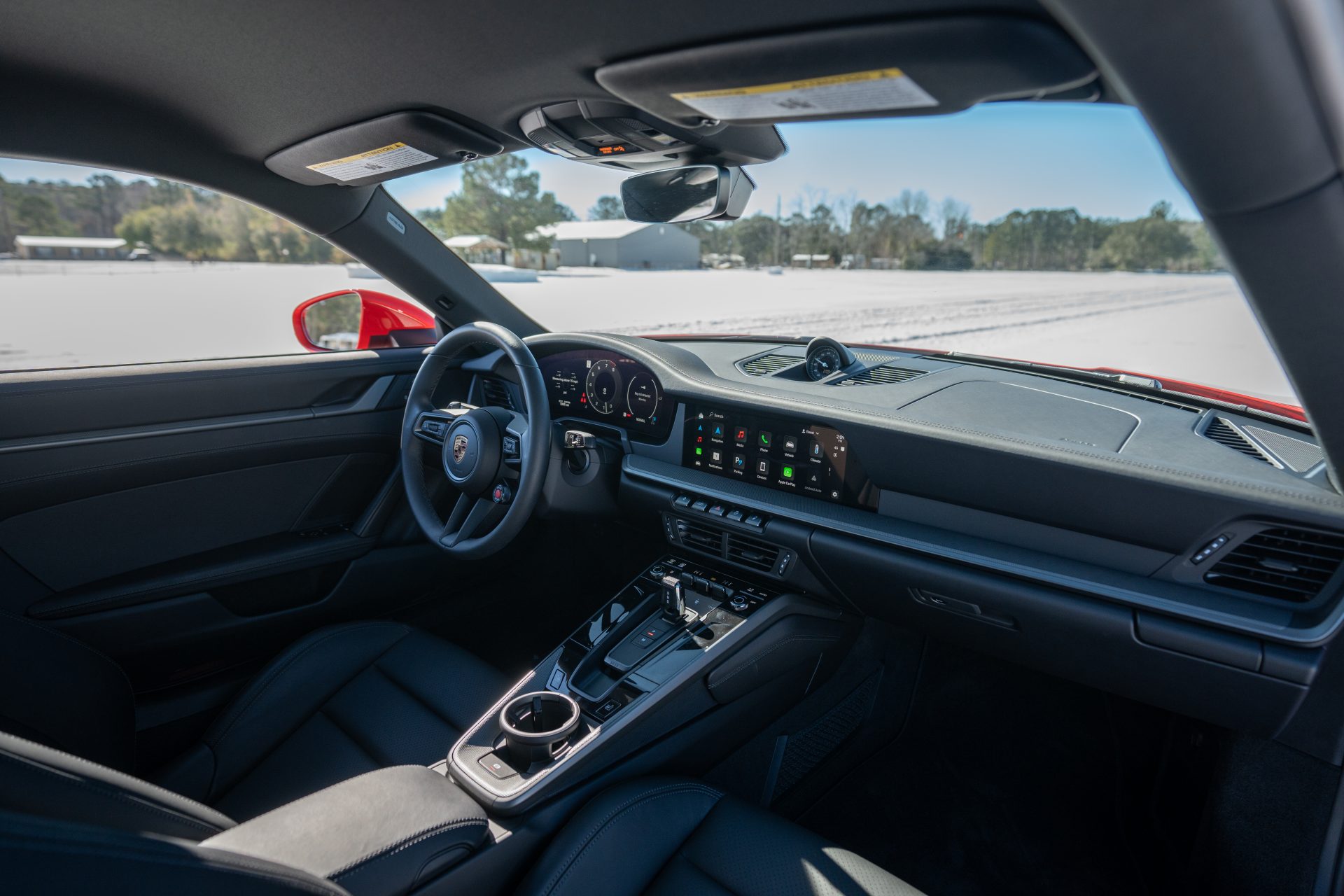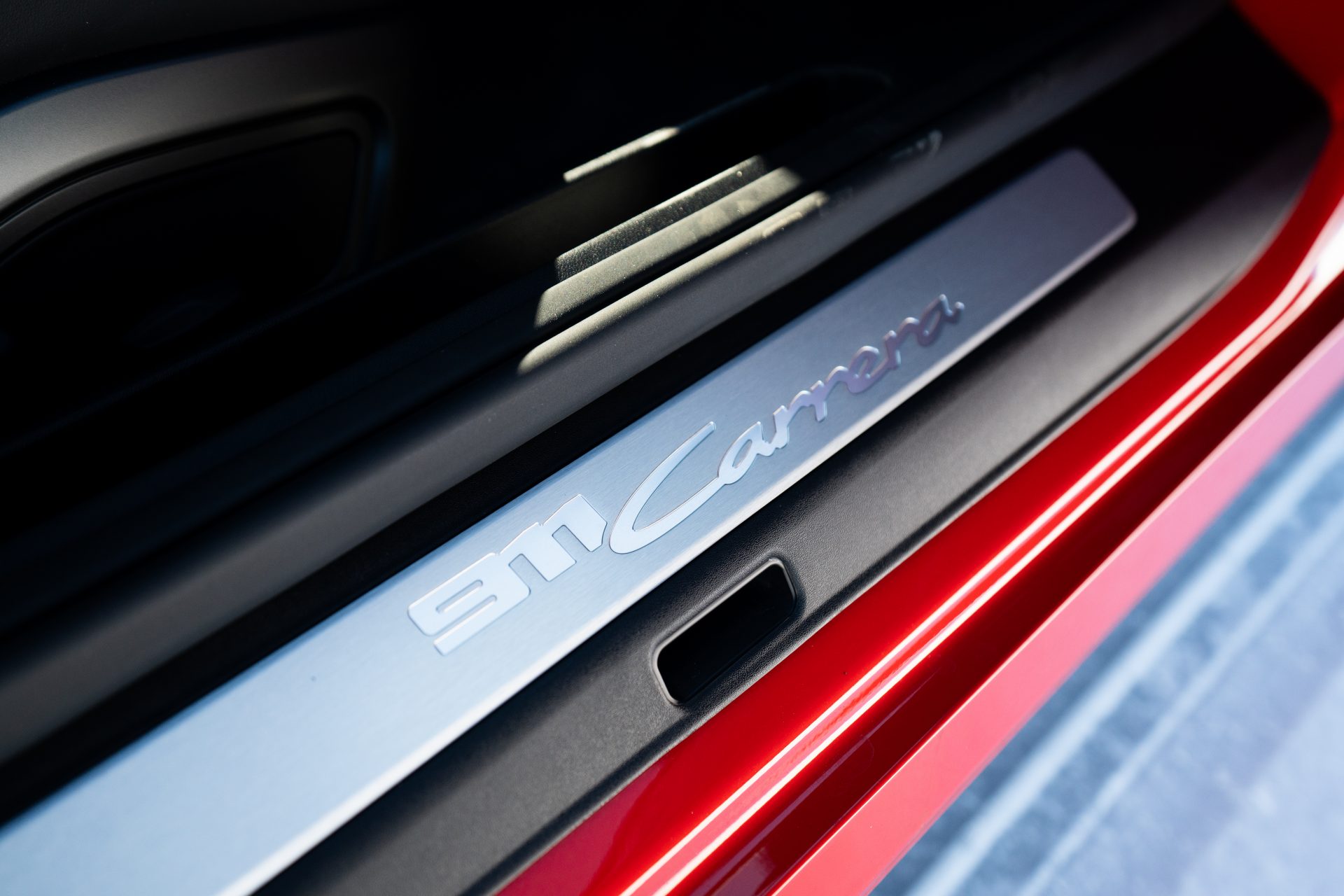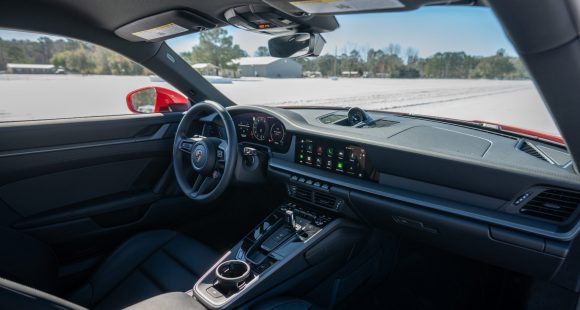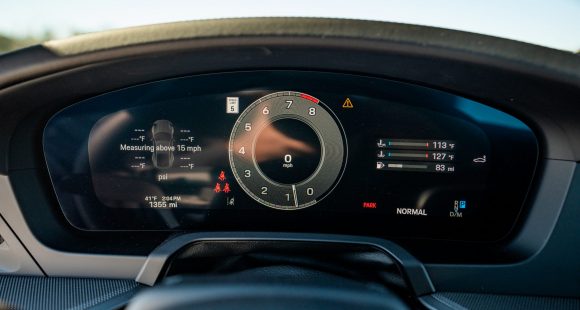2011 Chevrolet Volt
It was January of 2007 when General Motors first revealed its concept of an electric car with an onboard gasoline generator. It would be called Chevrolet Volt. Since then, we’ve been teased with numerous updates, and even had short drives in Volt prototypes. Well, now the time has come for the production Volt to greet its first real owners. And time for us to see if the Volt is really as electrifying as it’s hype.
General Motors has a lot riding on the 2011 Chevrolet Volt. This five-door compact’s revolutionary plug-in system is the cornerstone of GM’s green car efforts for the next decade. But, there are questions about how to classify the Volt. Is it an all-electric car as GM insists? Or, is it a very advanced plug-in gasoline-electric hybrid, with more in common with the Toyota Prius than the Nissan LEAF?
The best answer is, it’s both, depending on how it is driven. The Volt’s primary power source is always electric, with a 16 Kilowatt lithium-ion battery tied to a 149-horsepower electric drive motor. It provides a commute-friendly 35 to 45 mile electric-only range. But, when the battery is discharged, a 1.4-liter gasoline engine automatically starts, and turns a smaller motor/generator that provides juice for up to 310 miles, or until you run its 9.3 gallon gas tank dry.
 The controversy comes when you drive the Volt at speeds 70 miles an hour and above with the batteries depleted. Under this condition, the gasoline engine is mechanically linked to the drive wheels through the motor/generator. GM says this somewhat Prius-like feature boosts efficiency by 10 to 15%.
The controversy comes when you drive the Volt at speeds 70 miles an hour and above with the batteries depleted. Under this condition, the gasoline engine is mechanically linked to the drive wheels through the motor/generator. GM says this somewhat Prius-like feature boosts efficiency by 10 to 15%.
While GM kept this tidbit a secret waiting for patents to be approved, it does tarnish their all-electric claims. Still, we don’t think it matters. New car hype is just that. And we think owners will consider the Volt, first and foremost, an electric car, but one without pure-EV range limitations.
You can buy this vehicle and use it as a super-efficient, around town or commuter car, virtually never using any gasoline at all, or take it on a long family trip and know that you’ve got plenty of range to get to wherever your lunch stop or the next gasoline station might be.
So, how far does the Volt go on a gallon of premium gas? Well, again, it depends on how you drive it. If your commute is 15 to 20 miles, your MPG number will approach infinity. If you don’t recharge nightly, take long trips, or drive at high speeds, it’s more like 35-45 miles per gallon. But, then, you’re not the Volt’s target buyer. GM hopes the official government MPG-equivalent number will approach triple digits. We did see over 100 miles per gallon in two days of routine driving.
It takes about 10 to 12 hours to fully recharge the Volt using a 120-volt household outlet, about four hours at 240-volts. There’s even a smartphone apps to help to monitor charging and other Volt functions. Regenerative braking also helps replenish the battery. As to performance, Volt jolts from 0 to 60 in nine seconds. But it felt faster with strong throttle response. Top speed is about 100 miles per hour.
In all-electric mode, the Volt is smooth and quiet. Equally smooth is the transition from battery to gasoline power generation. Gas power sounds are muted until you bury the pedal. Then it sounds like most other four-cylinder engines under stress. There is also a Mountain Mode for sustained speed electric driving in hilly terrains.
Sharing a chassis with the Chevrolet Cruze, the independent front McPherson suspension and compound crank twist axle rear deliver a well-grounded drive experience. The ride is very solid. The Volt has a low center of gravity, so even going around tight corners, the car leans little. The steering is nicely dialed-in, and brakes are firm and linear. Most enthusiasts will be pleasantly surprised.
Although the production Volt has evolved since its concept days, most styling cues remain. A spit Chevy grille, tapered front corners, tight door seals, working front and rear spoilers, and low rolling resistance tires, that aid fuel economy, plus keep road noise low.
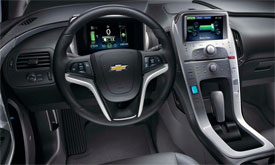 The Volt’s cockpit echoes the same clean look as the exterior. The upwardly swept dash houses an uncluttered instrument panel with unique readouts to help drivers maintain efficiency. The center stack has a large touchscreen display, soft touch switchgear, and a larger grabbable shifter.
The Volt’s cockpit echoes the same clean look as the exterior. The upwardly swept dash houses an uncluttered instrument panel with unique readouts to help drivers maintain efficiency. The center stack has a large touchscreen display, soft touch switchgear, and a larger grabbable shifter.
Standard is a Bose stereo, automatic climate control, remote ignition and Bluetooth. Hard drive navigation and rear-view camera are options. The Volt offers comfortable seating up front, with lots of leg and headroom for a six-footer, and optional heat. Rear passenger room is ample also, but remember, it’s only for two. Under the rear hatch, cargo volume is limited to 10.6 cubic feet, but the seatbacks do fold for more.
Base pricing for the Volt is $41,000 before federal and state tax breaks. Most buyers will pay no more than $33,500. Even more attractive is the Volt’s lease option, at $2,500 down and $350 a month.
With its unique extended range approach to green motoring, the 2011 Chevrolet Volt is impressive. No matter if you call it an electric car or a hybrid, it combines the best gas-saving, plug-in technologies yet available for an uncompromising driving experience. We think the Volt was well worth the wait, with or without the hype.
Specifications
- Engine: 16 Kilowatt Lithium-ion Battery1.4-Liter Gasoline Engine
- Horsepower: 149
- 0-60 MPH: 9.0 Seconds
2025 Porsche 911 Carrera
Ever Evolving 911 Reaches New Heights
The Porsche 911 has existed for 60 years now! Amazing! And, you could argue that major changes over all those years have been relatively few, as constant incremental improvement is more the way that Porsche does business. With that in mind, let’s hit the track in the latest 911 and see what constant improvement means for 2025.
We’ve driven so many 911s here at MotorWeek, each seemingly more special than the last, so it’s a bit refreshing to be ripping around Savannah’s Roebling Road Raceway in a 2025 Porsche 911 that’s about as close as you can get to base these days. And the fact that it’s just as fun as all those exclusive pieces says a lot about how far the 911 has come. Perhaps it also speaks to how much a base 911 will set you back today as well; more on that later.
For now, we’re just thinking about the next apex, holding steady throttle as we approach, and getting on it way sooner than you’d expect without upsetting anything, as the 911 rockets off the corner thanks to tremendous grip and a PDK trans that finds the perfect gear before we even gave it a thought. Even with very cold track temps, we never struggled for grip or battled any wheelspin coming off of corners. And trying to land it in that perfect spot in braking zones is easy with strong brake performance that was predictable and consistent lap after lap; no wandering, and great feedback too.
Yes, even the standard 911 is near pure perfection on a racetrack. It gives you all the right feedback, stays incredibly flat through corners, makes you always feel totally in control, and again is just plain fun. Unless you’re chasing lap times, there’s really no need to head further up the 911 tree. Though it is worth noting the few upgrades that were on our Carrera did help the situation a little. The 20- and 21-inch Carrera S wheels enabled plenty of grip from the 305 Pirelli P Zero tires, the Sport Chrono Package allows 0-60 sprints of 3.7 seconds, an extended range fuel tank meant we could lap all day without having to fill up, and the fantastic Sport Seats provided great support and better comfort than we remember experiencing in a 911. The Sport Exhaust system didn’t add anything to performance, but made things sound a whole lot better, and the oval silver tips look great too.
We never struggled for grip or battled any wheel spin coming off of corners.
Our track time got cut short thanks to a rare snowstorm in Coastal Georgia, but the white stuff and blue sky made the perfect backdrop for our Guards Red Carrera. Exterior tweaks for what is officially the 992.2 include a reshaped front fascia with improved aerodynamics. All front lighting is now contained within the Matrix Design LED headlight housing. The rear fascia has also been smoothed out, the license plate moved higher, and Porsche 3D block lettering spelled out across the back beneath the active rear spoiler and new decklid grille.
Even without Turbo in the name, the standard 911 engine is indeed a turbo these days, a 3.0-liter flat-six twin-turbo delivering 388 horsepower and 331 lb-ft strictly to the rear wheels in the Carrera Coupe.
Inside the cabin, the 911 continues its slow crawl towards the modern, now including a 12.6-inch fully digital gauge display and a start button located on the left side of the steering wheel, with drive modes easily accessible on the wheel itself. In another no brainer move, Porsche now makes the rear seat a no cost option, so you can choose if you want it or not.
Government Fuel Economy Ratings are 18 City, 25 Highway, and 21 Combined. That’s only slightly worse than average for the Energy Impact Score; 14.2 barrels of annual oil consumption with 7.0 tons of CO2 emissions.
The good news is this 911 had the fewest number of options of any Porsche that we’ve tested in some time, and it was still plenty awesome; the bad news is, a base Porsche 911 Carrera Coupe now starts at $122,095.
But can you really put value on “the force,” this mythical power that Porsche seems to have, that somehow turns average drivers into great ones? It’s useless to resist as far as we’re concerned, as it only gets better with the 2025 Porsche 911 Carrera.
Specifications
As Tested
- Engine: 3.0-liter twin-turbo flat-6
- Transmission: 8-speed PDK
- Horsepower: 388
- Torque: 331 lb-ft






























